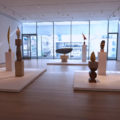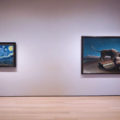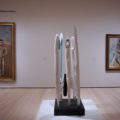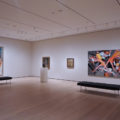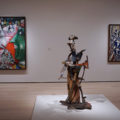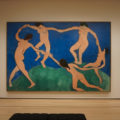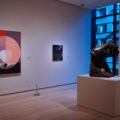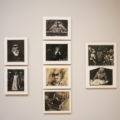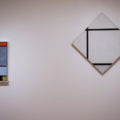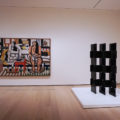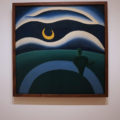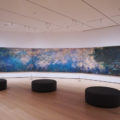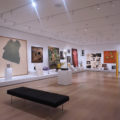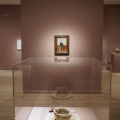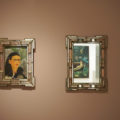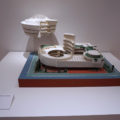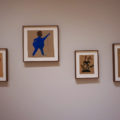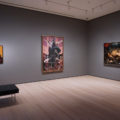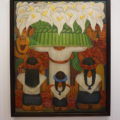[ad_1]

Haim Steinbach’s 2013 vinyl work hello again is mounted to the wall on MoMA’s first floor, welcoming visitors to the newly expanded museum. The work was acquired specifically for the reopening.
MAXIMILÍANO DURÓN/ARTNEWS
After a four-month-long closure and a $450 million renovation that has been years in the making the Museum of Modern Art in New York opened to members of the press on Thursday morning, October 10.
The reopening is perhaps this season’s most anticipated art event, and it occasionally lives up to the hype. In the run-up to the reopening, the museum promised that its new hang would redefine modern art. Reports ahead of the hang’s unveiling teased shocking combinations of old and new, and though some can be found (a particularly jarring one involves a famed Picasso alongside a great Faith Ringgold canvas), the permanent collection still follows a roughly chronological ordering of art history.
The results are less than earth-shattering. Mediums are frequently separated, and the histories of non-Western art that MoMA wants to tell are left incomplete—the curators have made subtle, superb changes to the way it presents art from Latin America and Eastern Europe, though it has dealt less successfully with art from Asia, Africa, and Oceania, as well as work by indigenous artists.
Still, there are some stunning juxtapositions and surprises along the way to be savored, for visiting the new MoMA after a months-long closure is akin to seeing a friend for a the first time in a while. Among the best parts of the hang is a room dedicated to the work and social circle of American artist Florine Stettheimer, who until the past few years has languished in the margins of art history. Another strong moment is the appearance of José Clemente Orozco’s six-panel fresco Dive Bomber and Tank, which the artist painted live at MoMA in 1940.
Below are the highlights from the museum’s fifth floor, which showcases work from the 1880s through the 1940s. (Parts 2 and 3, looking at the work on MoMA’s fourth and second floors, will be published in the coming days.)
The museum will officially reopen to the public on Monday, October 21, so mark your calendars.
-
MoMA’s permanent collection rehang opens with an airy gallery dedicated to the sculptures of Constantin Brâncuși.
MAXIMILÍANO DURÓN/ARTNEWS
-
Together at last: Vincent van Gogh’s iconic Starry Night, 1889, had long been given its own wall, but in the new hang, it’s paired with Henri Rousseau’s The Sleepy Gypsy, 1897.
MAXIMILÍANO DURÓN/ARTNEWS
-
A room historically dedicated to Picasso has some new visitors, including a “Personnage” sculpture by Louise Bourgeois, here shown flanked by his 1905 Boy Leading a Horse, left, and Bather, from 1908–09.
MAXIMILÍANO DURÓN/ARTNEWS
-
The other major juxtaposition is MoMA’s cornerstone piece by Picasso, Les Demoiselles d’Avignon from 1907, with, at far right, Faith Ringgold’s 1967 American People Series #20: Die, which the museum acquired in 2016.
MAXIMILÍANO DURÓN/ARTNEWS
-
From left, Marc Chagall’s I and the Village (1911), Vladimir Baranoff-Rossiné Symphony Number 1 (1913), and Fernand Léger’s Exit the Ballets Russes (1914).
MAXIMILÍANO DURÓN/ARTNEWS
-
Matisse’s Dance (I), from 1909, is still the centerpiece in a room dedicated to his work.
MAXIMILÍANO DURÓN/ARTNEWS
-
From left, Hilma af Klint’s The Dove, No. 2, Series UW, Group IX (1915), Georgia O’Keeffe’s Lake George, Coat and Red (1919), and Raymond Duchamp-Villon’s The Horse (1914, cast ca. 1930–31).
MAXIMILÍANO DURÓN/ARTNEWS
-
In the foreground are Marcel Duchamp’s iconic, groundbreaking readymades of a bicycle wheel and a shovel.
MAXIMILÍANO DURÓN/ARTNEWS
-
One pleasant surprise is the room dedicated to the once-obscure American artist Florine Stettheimer, whose vision for modern art spanned from paintings to the salons of intellectuals she organized and this functional room divider. Titled Four Panel Screen, the work was once a centerpiece in her home, and it depicts the artist, at far right, and her three siblings.
MAXIMILÍANO DURÓN/ARTNEWS
-
This installation looks at the ways in which 20th-century photography captured racist anxieties of the “other,” and how they manifested in popular depictions of “monsters”—from Frankenstein’s monster to mummies and vampires.
MAXIMILÍANO DURÓN/ARTNEWS
-
Two choice works by Piet Mondrain from the 1920s, from left: Composition with Red, Blue, Black, Yellow, and Gray (1921) and Tableau I: Lozenge with Four Lines and Gray (1926).
MAXIMILÍANO DURÓN/ARTNEWS
-
A suite of design objects from chairs to tea sets and clocks, by the likes of some of the 20th century’s towering figures in design from architects Ludwig Mies van der Rohe and Marcel Breuer to graphic designer Ladislav Sutnar and photographer Marianne Brandt.
MAXIMILÍANO DURÓN/ARTNEWS
-
In a room about Paris in the 1920s is this juxtaposition Fernand Léger’s Three Women, 1921–22, with Eileen Gray’s lacquered wood Screen, 1922—and nearby…
MAXIMILÍANO DURÓN/ARTNEWS
-
…is this stunning Tarsila do Amaral, titled The Moon from 1928, which hangs across from a Brancusi bronze, on a mixed-media pedestal, and Picasso’s Three Musicians.
MAXIMILÍANO DURÓN/ARTNEWS
-
In a quiet corner for contemplation, Claude Monet’s three-panel Water Lilies, 1914–26, takes pride of place in a room dedicated to the work he produced at his country residence in Giverny, France. The works entered the collection in 1959.
MAXIMILÍANO DURÓN/ARTNEWS
-
As part of an ongoing series, titled “Artist’s Choice,” MoMA has invited Amy Sillman to organize a full gallery on the museum’s fifth floor of works from its collection. Her outing focuses on the shapes of painting and sculpture in the collection and is aptly titled “The Shape of Shape.”
MAXIMILÍANO DURÓN/ARTNEWS
-
Among Méret Oppenheim’s best-known works is her fur-covered cup, saucer, and spoon, collectively titled Object, which now sits in front of Frida Kahlo’s 1940 Self-Portrait with Cropped Hair.
MAXIMILÍANO DURÓN/ARTNEWS
-
André Breton, the famed leader of the Surrealists, loved Frida Kahlo’s work and identified her as a Surrealist. The artist herself disagreed. She famously said, “I never painted dreams. I painted my own reality.” Still, MoMA has included this Kahlo work, Fulang-Chang and I, 1937, in a section about Surrealism, where the piece sits across from the section looking at the precedents to the movement. Caught in its reflection is a work by Henri Rousseau.
MAXIMILÍANO DURÓN/ARTNEWS
-
A room titled “A Surrealist Art History” explores precedents to Surrealism and includes Giorgio de Chirico’s The Anxious Journey, 1913.
MAXIMILÍANO DURÓN/ARTNEWS
-
A nod to one of New York’s other museums comes in a section titled “Architecture for Modern Art.” Shown here is a maquette of Frank Lloyd Wright’s design for the Guggenheim Museum, located about 40 blocks north of MoMA.
MAXIMILÍANO DURÓN/ARTNEWS
-
Four stunning works by the great Bill Traylor.
MAXIMILÍANO DURÓN/ARTNEWS
-
A stunning trio, from left: Rufino Tamayo’s Animals (1941), Francis Bacon’s Painting (1946), and David Alfaro Siqueiros’s Collective Suidice (1936).
MAXIMILÍANO DURÓN/ARTNEWS
-
José Clemente Orozco’s six-panel fresco Dive Bomber and Tank was commissioned by MoMA and painted live at the museum during its “Twenty Centuries of Mexican Art” exhibition in 1940.
MAXIMILÍANO DURÓN/ARTNEWS
-
Diego Rivera’s Flower Festival: Feast of Santa Anita, 1931, hangs across from an escalator.
MAXIMILÍANO DURÓN/ARTNEWS
[ad_2]
Source link


